Spring Festival Couplets (Chunlian)
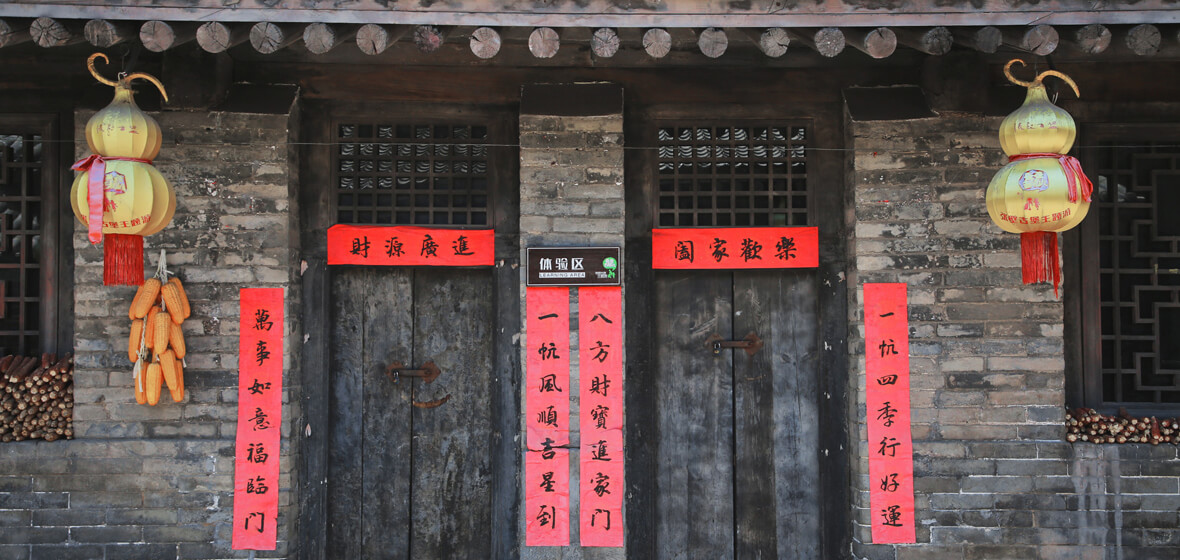
What is Chunlian?
Spring Festival couplets or Chinese New Year couplets, also known as Chunlian 春联|春聯 (chūn lián) in Chinese, are traditional poetic verses written on red paper strips and displayed on and beside the front doors of homes during the Chinese New Year, also known as the Spring Festival. They are an essential part of Chinese New Year decorations.
The words of the couplets vary, but they all talk about family unity, positive aspirations, business prosperity, and well-being. People usually pick words carefully to bring luck and good wishes. People use Chinese calligraphy to write the couplets, adding a bit of art to the overall presentation. In order to make beautiful couplets, some individuals may seek the services of professional calligraphers.
The placement of Spring Festival couplets is believed to keep bad spirits away and bring good luck into the home. Spring Festival couplets are not only decorative elements but also of cultural and symbolic importance. They add a festive atmosphere to homes and communities during the Chinese New Year celebrations, and this custom is still going strong in China and among Chinese communities around the world today.
What are the 3 Parts of Spring Festival Couplets?
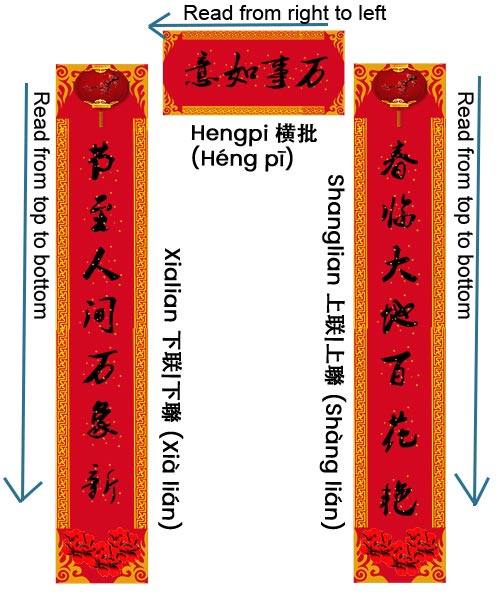
Xialian: The festive season comes, all things become new.
Hengpi: May all your wishes come true.
The "Chunlian" or Spring Festival couplets consist of three parts:
The First Line (Upper Scroll) or Shanglian 上联|上聯 (Shàng lián)
Shanglian is the first line of the couplet, usually placed on the right side of the door. It is written vertically from top to bottom. It is about 5, 7, 9 or 11 Chinese characters. It typically conveys New Year’s blessings or good wishes .
The Second Line (Lower Scroll) or Xialian 下联|下聯 (Xià lián)
Xialian is the second line of the couplet, placed on the left side of the door. Like the Shanglian, it is also written vertically. The Xialian often echoes the Shanglian , finishing off the couplet with a matching phrase or thought.
The Horizontal Scroll or Hengpi 横批 (Héng pī)
Hengpi is the horizontal scroll or horizontal piece that is placed above the doorframe.It is a brief phrase (usually consisting of 4 characters) that connects and summarizes the meaning of the couplet.
These three parts together make a full set of Spring Festival couplets, which are all about good wishes, luck, and hope for the new year.
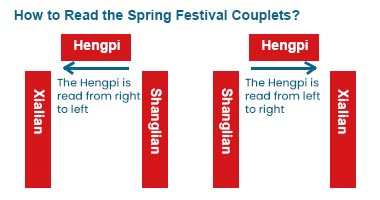
In order to adapt to the reading order of the Hengpi, sometimes the positions of the Shanglian and the Xialian of the 'Spring Festival Couplets' might be switched . If the Hengpi is read from left to right, then the left side will be the Shanglian and the right side will be the Xialian.
How to Paste Chinese New Year Couplets?
When people put up Spring Festival couplets varies from region to region and according to custom, though they are generally posted on the Chinese New Year's Eve.
In general, Spring Festival couplets are posted between 6am and 12pm on New Year's Eve. The new couplets are put up, symbolizing swapping out the old for the new, and hoping for good fortune in the new year.
Some areas put up the couplets in the afternoon of New Year's Eve, mostly local businesses who then close up shop and rest for the New Year after putting up the couplets.
The pasting order is: Shanglian -> Xialian -> Hengpi.
According to Chinese tradition, the Lantern Festival symbolizes the end of the Spring Festival. Hence, people need to ensure that the Spring Couplets are securely posted until the end of the Lantern Festival.
History of Chunlian
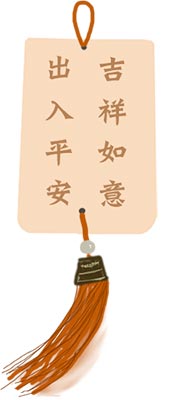
"Go in and out safety,
auspiciousness and satisfaction
in all things."
The origins of Chunlian (Spring Festival couplets) can be traced back to ancient Chinese customs and traditions. The practice of hanging couplets during the Spring Festival has a long history and has evolved over time.
One possible origin can be found in the Tang Dynasty (618-907 CE), when people would write the names or images of two deities, Shen Tu and Yu Lei on Taofu( peach wood charms) and hang them on doors to ward off evil spirits and bad luck. These peach wood charms eventually transformed into paper couplets with written blessings and well-wishes.
Another origin can be attributed to the Song Dynasty (960-1279 CE), when people began writing auspicious phrases on red paper and pasting them on gates or doors during the Spring Festival. This was believed to bring blessings and good luck to the household for the upcoming year.
Meng Chang, ruler of Later Shu(934-966CE) ordered one of his scholars to compose a new year charm in the form of a couplet scrolls to decorate his bed-chamber door, but the result did not please him. So he wrote a couplet himself which was the now regarded as the first pair of Spring Festival couplets: 新年纳余庆,佳节号长春 (xīn nián nà yú qìng, jiā jiē hào zhǎng chūn) - "The New Year embraces all good luck and gladness; The great festival is named Perpectual Spring."
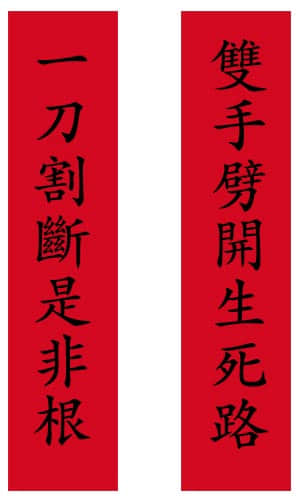
Chunlian gained popularity among the general population during the Ming Dynasty (1368-1644). And the name ”Chunlian” was coined then . The Emperor Hongwu, the founder of the Ming Dynasty, was a big fan of Chunlian. He ordered that everyone, no mater how rich or poor, should display a spring couplet on their main door on New Year's Day. Curious to observe his subjects' compliance, the Emperor disguised himself and went out to check their efforts. Most had nice couplets, except for a certain illiterate butcher (also in business of Pig Castration) who had enlisted someone else to fulfill the imperial order. In an act of amusement, the Emperor personally wrote a couplet on scrolls, which read: 双手劈开生死路 ,一刀割断是非根 | 雙手劈開生死路, 一刀割斷是非根 (shuāng shǒu pī kāi shēng sǐ lù, yī dāo gē duàn shì fēi gēn) . "With one blow of the hands, the road to life and death is cleft open; With one stroke of the knife, the root of right and wrong is cut off." People began hanging the couplets on their doorways, believing they would bring luck, fortune, and protection to the household in the coming year.
Over time, putting up the couplets during the Spring Festival spread and became more widespread, with the couplets taking on their characteristic red color and poetic style. People believe that the red paper can keep away evil spirits and bring good fortune.
People usually write couplets in poetic form, following specific rules and conventions of Chinese poetry. Today, putting up the Spring Festival couplets continues to be an important part of Chinese New Year celebrations . They are a way to welcome the new year with happy vibes and to bring good fortune and blessings to the household.
4 Popular Chunlian Examples along with English Translations
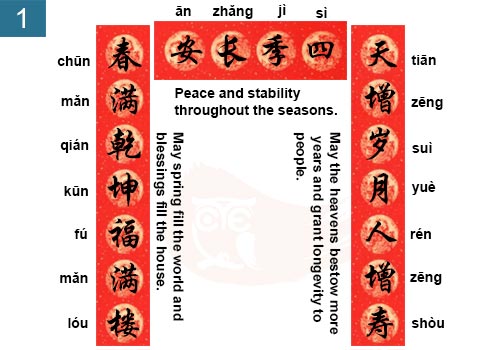
1. Shanglian 上联 (Shàng lián): 天增岁月人增寿 (tiān zēng suì yuè rén zēng shòu)
English: May the heavens bestow more years and grant longevity to people.
Xialian 下联 (Xià lián): 春满乾坤福满楼 (chūn mǎn qián kūn fú mǎn lóu)
English: May spring fill the world and blessings fill the house.
Hengpi 横批 (Héng pī): 四季长安 (sì jì zhǎng ān)
English: Peace and stability throughout the seasons.
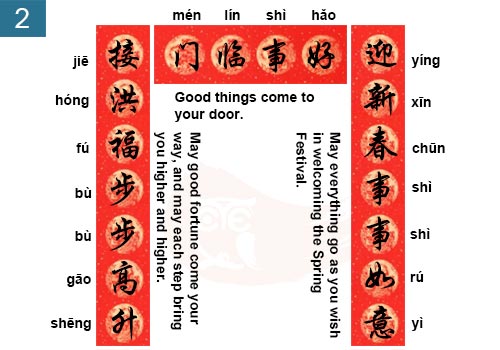
2. Shanglian 上联 (Shàng lián): 迎新春事事如意 (yíng xīn chūn shì shì rú yì)
English: May everything go as you wish in welcoming the Spring Festival.
Xialian 下联 (Xià lián): 接洪福步步高升 (jiē hóng fú bù bù gāo shēng)
English: May good fortune come your way, and may each step bring you higher and higher.
Hengpi 横批 (Héng pī): 好事临门 (hǎo shì lín mén)
English: Good things come to your door.
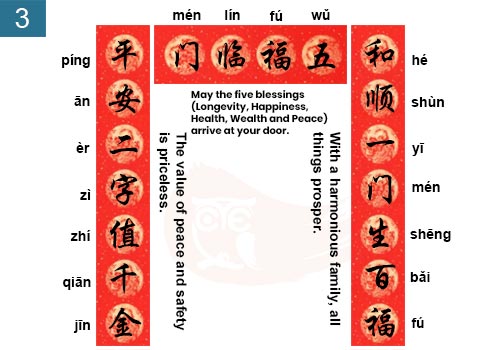
3. Shanglian 上联 (Shàng lián): 和顺一门生百福 (hé shùn yī mén shēng bǎi fú)
English: With a harmonious family, all things prosper.
Xialian 下联 (Xià lián): 平安二字值千金( píng ān èr zì zhí qiān jīn)
English: The value of peace and safety is priceless.
Hengpi 横批 (Héng pī): 五福临门 (wǔ fú lín mén)
English: May the five blessings(Longevity, Happiness, Health, Wealth and Peace) arrive at your door.
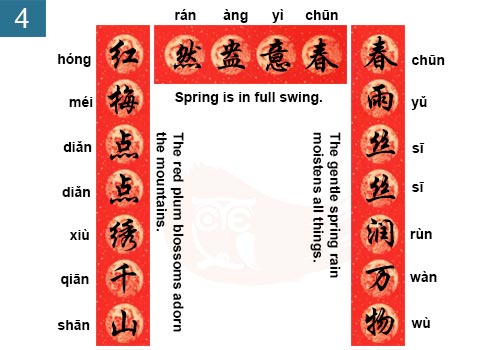
4. Shanglian 上联 (Shàng lián): 春雨丝丝润万物 (chūn yǔ sī sī rùn wàn wù)
English: The gentle spring rain moistens all things.
Xialian 下联 (Xià lián): 红梅点点绣千山 (hóng méi diǎn diǎn xiù qiān shān)
English: The red plum blossoms adorn the mountains.
Hengpi 横批 (Héng pī): 春意盎然 (chūn yì àng rán)
English: Spring is in full swing.
OR
Are you eager to begin your Chinese cultural journey?
Drop us a line and we will promptly connect you with our leading China expert!
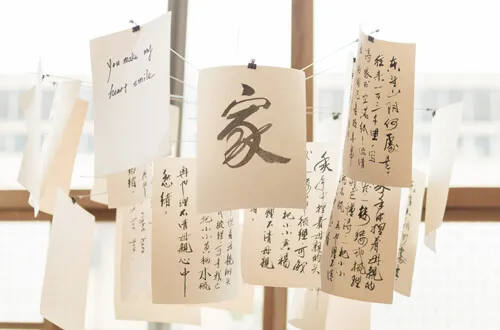 Chinese Calligraphy
Chinese Calligraphy 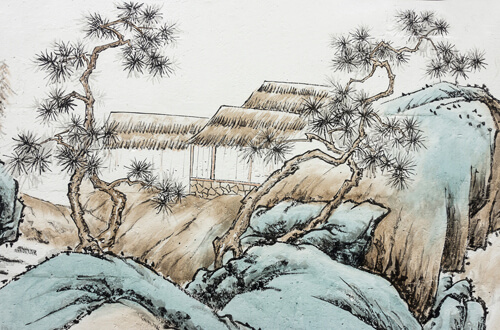 Chinese Painting
Chinese Painting 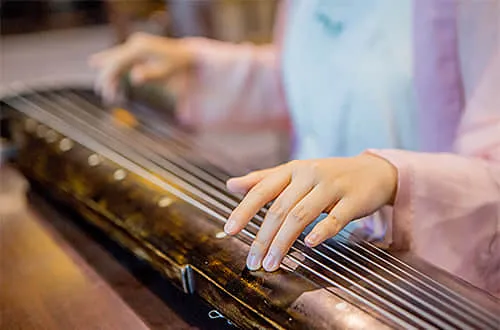 Chinese Music
Chinese Music 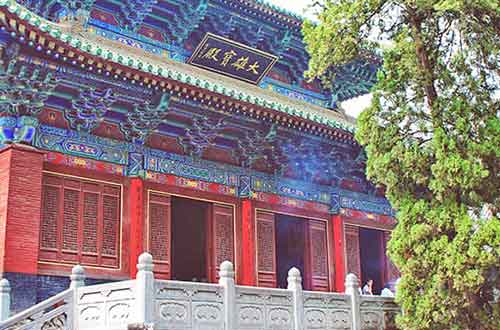 Top 5 Origin Place of Kungfu
Top 5 Origin Place of Kungfu